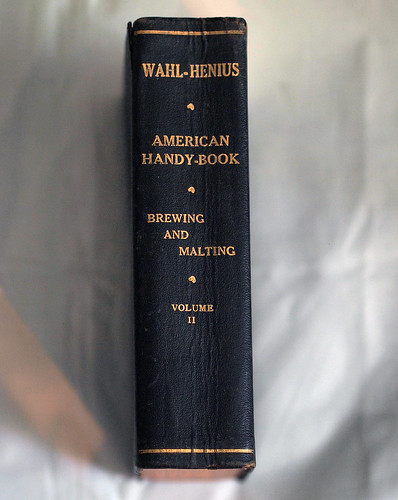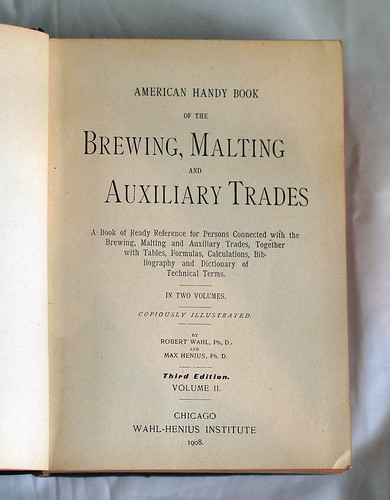In 1901, preeminent American brewing scientists Max Henius and Robert Wahl, published —
The American Handy-Book of the Brewing, Malting and Auxiliary Trades: A Book of Ready Reference for Persons Connected with the Brewing, Malting and Auxiliary Trades, Together with Tables, Formulas, Calculations, Bibliography and Dictionary of Technical Terms
— which could be considered the Bible of American brewing, or at least the Old Testament thereof: a historical window into the brewing practices of turn-of-the-last-century America.
From their preface:
The American Handy-Book of the Brewing, Malting and Auxiliary Trades is designed to be a book of ready reference for the use of persons connected with the trades designated. It does not pretend to be a text-book, which the student of brewing will read through from beginning to end with a view of becoming acquainted with the principles and practice of this great industry. It aims to be, as it were, a pocket encyclopedia, by reference to which the brewer, maltster, refrigerating machine engineer, bottler, etc., as a person engaged in the commercial activities of a brewery, may find an immediate answer to questions that may come up in connection with the exercise of his calling, without requiring him to wade through bulky volumes and peruse quantities of information in search of a single item of knowledge.
The initial printing quickly sold out; Wahl and Henius released a second edition the following year. They published a revised, third edition in 1908, in two volumes covering 1,266 pages. An excerpt from its preface:
In these days of railroads, telephones, wireless telegraphs and rudimentary airships, six years, measured by achievement rather than by hour-glass, represent a considerable period of time. It is six years since the second edition of the Handy-Book of the Brewing, Malting and Auxiliary Trades was published, and the brewing trade has made rapid strides in that time. Many things current six years ago have been dropped and new even have taken their places. The second edition having been exhausted for over two years, a new one, taking account of the march of progress, has become necessary.
There have been important changes in the general plan of the work, and many changes of detail have been introduced.
Naturally, the more general adoption of electrical machinery in brewery and malthouse operations, growing out of the rapid development of those devices, calls for more extensive consideration. A new chapter has therefore been added on "Electricity and Magnetism." Likewise, the attention devoted of late years to the study of the barley plant and other agricultural products connected with the industry, bringing into prominence the importance of botanical marks of plants, is one of the reasons for the addition of chapters on "Botany" and "Barley." It goes without saying that the constant development of brewing methods, leading in some instances to the elaboration of entirely new systems of brewing, called for the separate treatment of "Special Brewing Systems." Another development of recent years grows out of the agitation for pure food and consequent legislation, affording grounds for a new chapter on "Beer Standards."
**************
Who was Max Henius?
Max Henius was probably America’s greatest brewing scientist, in any era. Yet he is virtually unknown to most beer and brewing fans, even those with some historical knowledge. He co-authored in 1902 the American Handy-Book of the Brewing, Malting, and Auxiliary Trades. The other writer was Dr. Robert Wahl, an American Henius had studied with in Marburg, Germany. The book was a stupendous achievement, a fat tome of 1200 pages covering every conceivable aspect of brewing operations. Many questions of science and theory were addressed but in a way accessible to practical brewing people. [...] Anyone who investigates American brewing history runs into the book sooner or later. The modern beer writer, Michael Jackson, who developed the basic stylistic schema of craft brewing, almost certainly read the book. Jackson’s basic classification seems based on Wahl & Henius’ work, not just the “ur” distinction between bottom-fermentation, top-fermentation, and spontaneous fermentation but the main beer types under each of those heads.—Gary Gillman ( Beer st Seq.).
**************
What was the Wahl-Henius Institute of Fermentology?
The Wahl-Henius Institute was a brewing research laboratory and school in Chicago that operated between 1886 and 1921. Founded in 1886 by Dr Robert Wahl and Dr Max Henius as the Wahl & Henius, the name was changed to the Scientific Station for Brewing of Chicago and then to the Institute of Fermentology before becoming the Wahl-Henius Institute. Its educational division, the American Brewing Academy, was created in 1891. The school and laboratory operated successfully until Prohibition, when the near dissolution of the brewing trade forced its closure and sale to the American Institute of Baking, which retains the nucleus of the Wahl-Henius library.—Randy Mosher ( Craft Beer & Brewing Magazine).
-----more-----
- More photos of the book: here.
- Pic(k) of the Week: one in a weekly series of photos taken (or noted) by me, posted on Saturdays, and often, but not always, with a good fermentable as the subject.
- Camera: Olympus Pen E-PL1.
- Commercial reproduction requires explicit permission, as per Creative Commons.
- For more from YFGF:
- Follow on Twitter: @Cizauskas.
- Like on Facebook: YoursForGoodFermentables.
- Follow on Flickr: Cizauskas.
- Follow on Instagram: @tcizauskas.











No comments:
Post a Comment
Comment here ...